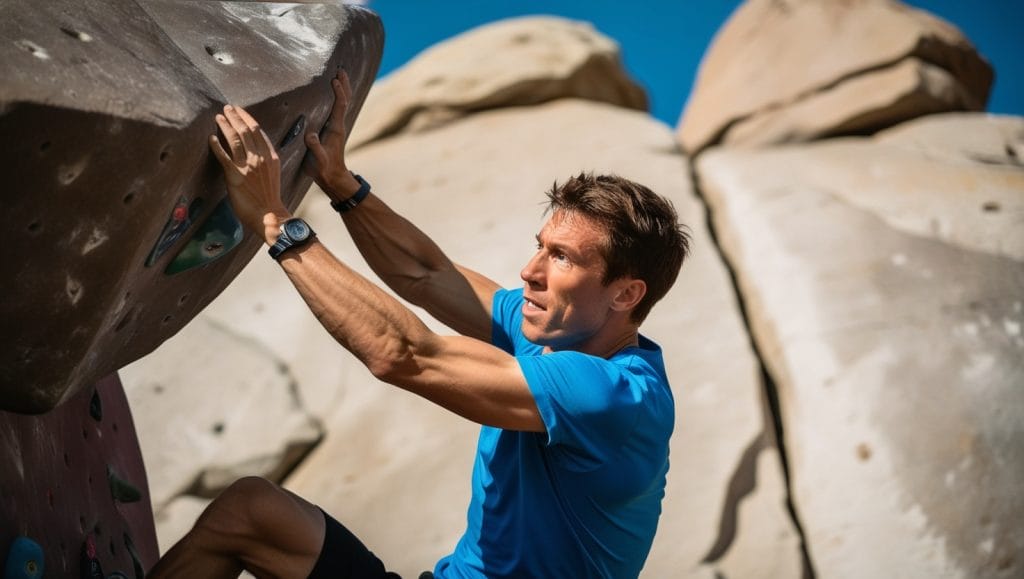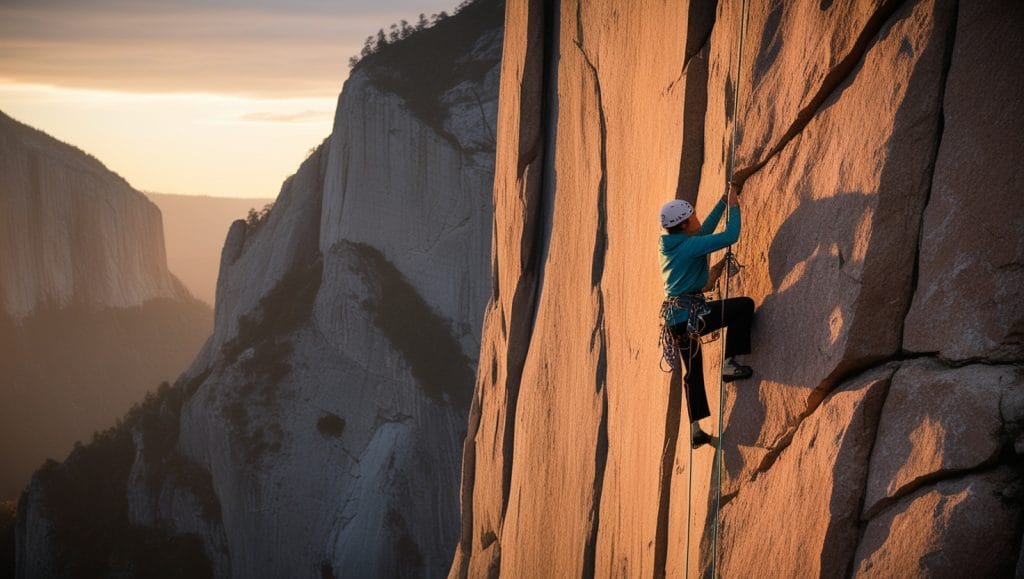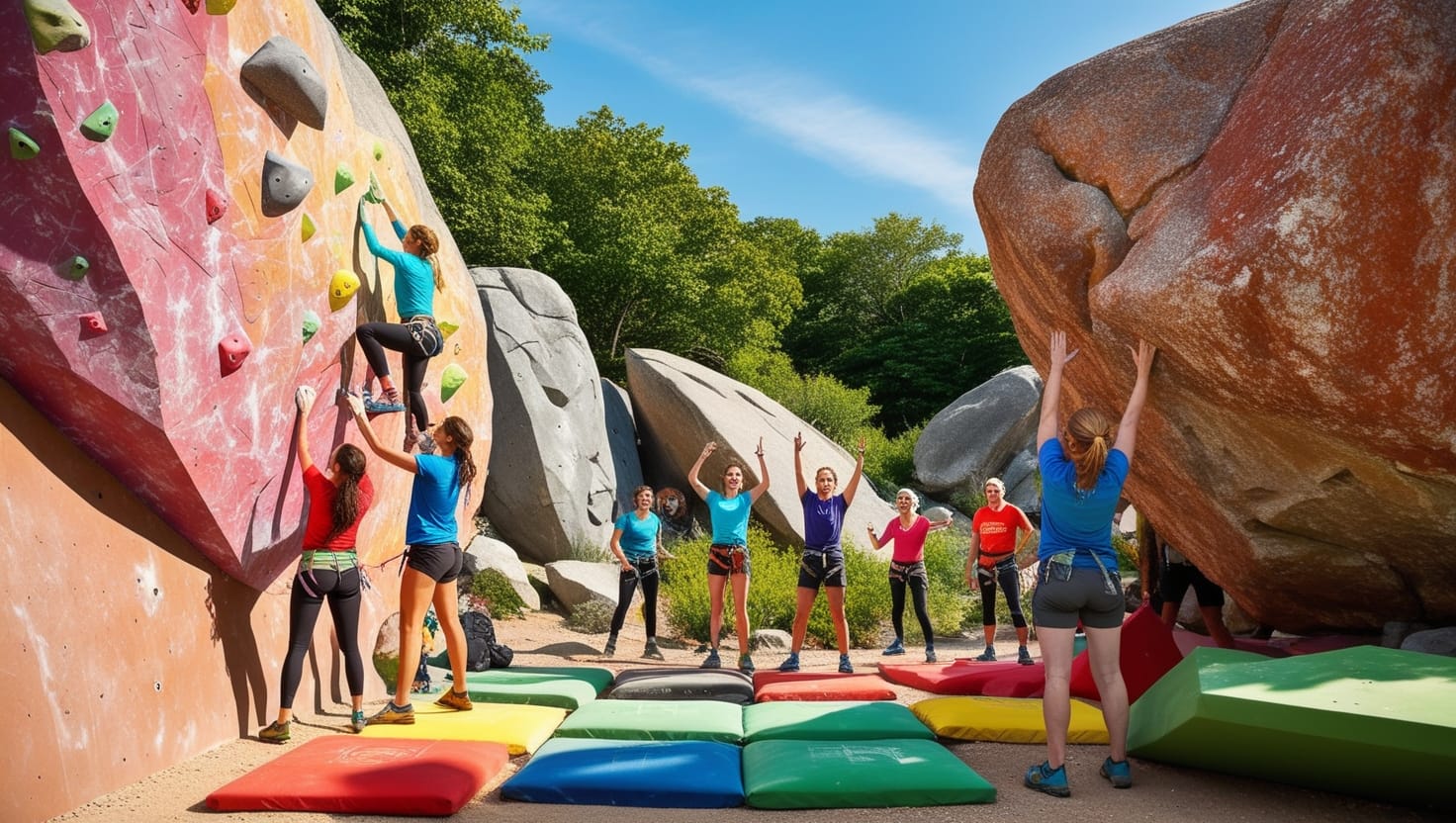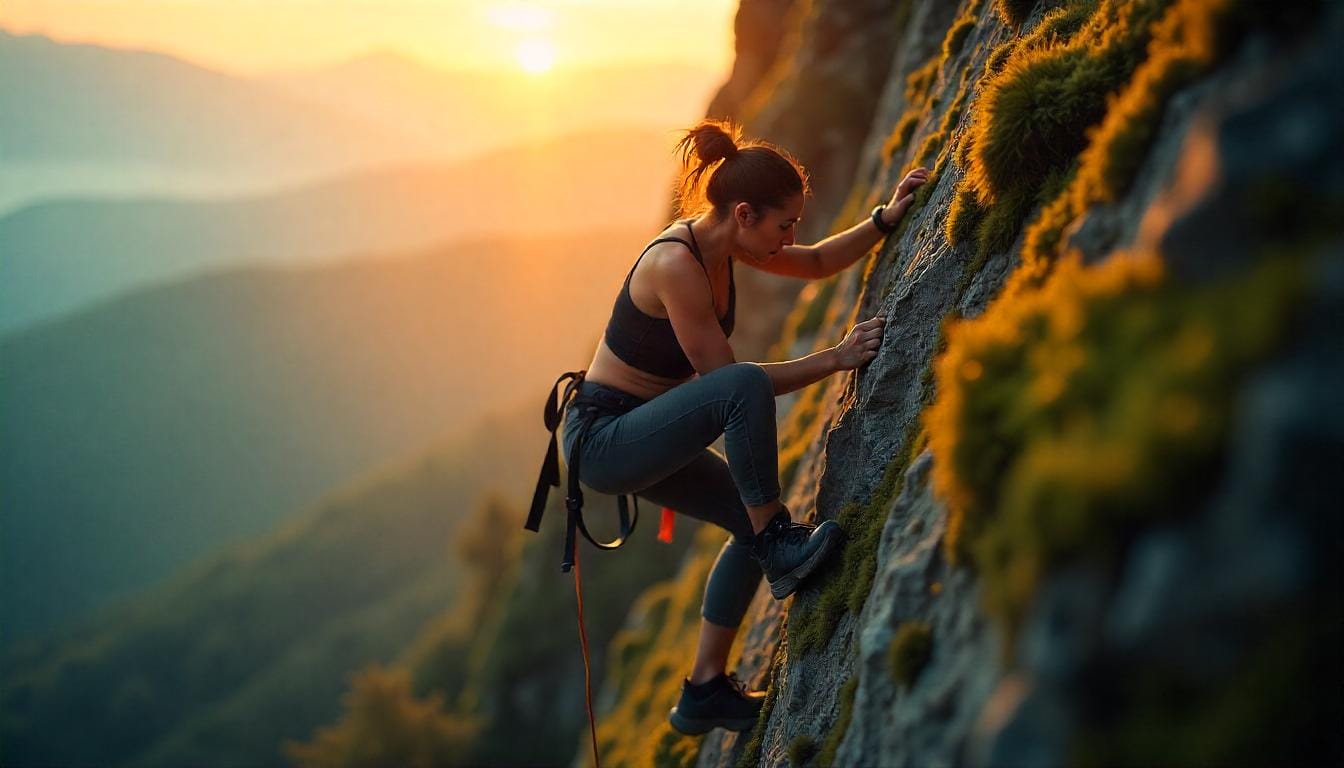The history of bouldering is an intriguing one. It started as a way for rock climbers to train, but over time, it blossomed into a popular sport with its own competitions and community. Bouldering involves climbing small rock formations or artificial walls without using ropes.
This article will take you on a journey through the evolution of bouldering and introduce you to some of its famous climbers. Keep reading to discover how this unique form of rock climbing has forever changed the sport.
Key Takeaway
- Bouldering started as a way for rock climbers to train, but it eventually became a recognized sport on its own.
- Key figures like John Gill and Pierre Allain played important roles in shaping the development of bouldering.
- Today, bouldering includes competitions and a tight-knit community of passionate climbers.
Early Beginnings
Credits : Climbing Stuff
Bouldering started to become popular in the late 1800s, especially in Europe. Climbers noticed that practicing on big rocks helped them get better at climbing. Instead of climbing tall rock walls, they focused on smaller rocks. This was easier and allowed them to try out different moves without the risks of high climbing. Groups of climbers would meet at local spots, encouraging each other to tackle difficult climbs. This teamwork made climbing more fun and exciting.
In the 1930s, a climber named Pierre Allain came up with new ways to climb tricky routes. This was also when climbers started using better shoes that helped them grip the rocks better. A forest near Paris called Fontainebleau became a popular spot for bouldering. Many climbers went there because it had lots of different types of rocks to climb. This area is known as the birthplace of modern bouldering, and climbers from all over came to try their skills on its famous rocks (1).
Evolution into a Sport
By the 1950s and 1960s, bouldering was starting to be seen as more than just a way to practice climbing. Climbers started writing down their climbs, the hard parts, and the things they did well. This helped create a community of climbers. John Gill, who is known as the “Father of Modern Bouldering,” played an important role in this. He not only made bouldering into a serious climbing activity, but he also came up with new ways to climb and new ideas about the sport.
During this time, bouldering became more organized. Climbers started setting specific problems for others to try. This made it easier for people to climb the same routes. This led to more interest in bouldering as a sport. As it became more popular, climbers started having friendly competitions to see who could solve the hardest climbing problems. The climbing community kept growing as more people got interested in bouldering and wanted to join in on the fun and challenges (2).
Safety Innovations

In the 1980s, something new called crash pads changed everything for bouldering. Before this, climbers could get seriously hurt when they fell off the rocks. Many people got injured because there wasn’t anything to break their fall. But the crash pads had soft cushions that kept climbers safe. This meant they could try harder climbing problems without being as scared of getting hurt. The crash pads gave climbers the freedom to push themselves and try new ways of climbing.
With better safety, more people started climbing. They knew they had the crash pads to protect them, so they wanted to join in on the fun. The crash pads also allowed climbers to try even taller and riskier problems. Climbers began to attempt more difficult routes, testing both their strength and their problem-solving skills. This made bouldering not only safer, but also more exciting for everyone who did it.
Modern Bouldering
Bouldering is more popular than ever today. You can find it at indoor climbing gyms and outdoor rock spots. Many gyms have special bouldering areas with all kinds of climbing problems to try. These gyms have walls of different heights and angles, so climbers can practice their skills year-round, no matter the weather. Indoor bouldering also makes it easier for beginners to get started. Lots of gyms offer classes and coaches to teach new climbers the basics in a safe way.
Bouldering competitions have also become a big part of the sport today. Events like the IFSC Climbing World Cup bring climbers from all over the world to compete. These competitions show off a wide range of skills, including strength, technique, and creativity. The climbers compete on special climbing problems that test their abilities. Spectators love watching the climbers figure out the problems and try to complete the challenging routes. The excitement of these events has helped get more people interested in bouldering, with new climbers and fans joining in on the fun.
Cultural Impact
Bouldering has had a big impact on the climbing community. It has brought climbers together, making them feel like they are part of a strong group. Climbers share their experiences and achievements on social media, connecting with others who love the sport just as much. They share tips and tricks, and this community keeps growing, inspiring new ways of climbing.
Climbers also support and celebrate each other’s accomplishments, like finishing a hard climb or trying new techniques. More people are starting to see bouldering as a real sport, especially now that it’s in the Olympics. This has brought more attention to the climbing community and encouraged more people to try it.
As bouldering continues to grow and change, it remains an exciting and important part of climbing culture.
Notable Figures and Areas
There are some really famous climbers who have made a big mark on the sport of bouldering. Lynn Hill was one of the first women who was really great at bouldering. She inspired a lot of other climbers, especially women, to try the sport. Adam Ondra and Alex Honnold are also well-known climbers who are really talented at climbing on rocks and boulders. Their amazing skills and hard work have motivated many people to take up climbing as a hobby and a sport.
There are also some famous places for bouldering around the world. Joshua Tree National Park in California has unique rock formations that climbers love to climb on. Smith Rock in Oregon is another popular spot, with all kinds of challenging routes for climbers to try. These places are beautiful, and climbers love going there to tackle the exciting climbing problems. The popularity of these areas shows how much people enjoy bouldering and how the bouldering community keeps growing.
Bouldering Competitions
Bouldering has become a big part of the climbing world. Top climbers from all over compete in events like the World Bouldering Championships and the IFSC Climbing World Cup. These competitions have different climbing problems that test the climbers’ skills and creativity. The problems can be easy or very hard, making the competitions exciting for the climbers and the people watching.
These competitions show off the climbers’ talents. They also encourage the climbers to get even better. The climbers learn new ways to climb from each other. The competitions have a fun and positive atmosphere, which helps the climbers feel connected.
As bouldering becomes more popular, there are more competitions for climbers to take part in. This gives them more chances to show off their climbing skills and be part of the growing bouldering community (3).
The Future of Bouldering

The future of bouldering looks really good. More and more people are getting interested in the sport, both for competitions and just for fun. Now that climbing is part of the Olympics, even more people are curious about bouldering. And the sport keeps getting better with new climbing techniques and equipment.
Indoor climbing gyms are also expanding, giving climbers more places to practice. This means climbers can work on their skills all year round, no matter the weather outside. The climbing community is really excited about where bouldering is headed. They can’t wait to see how the sport keeps changing and growing. With a strong foundation and more people getting into it, bouldering is sure to stay an exciting and fun part of the climbing world.
FAQ
How did bouldering evolve from traditional climbing and free climbing in Yosemite Valley?
Bouldering started as a training method for big wall climbing in Yosemite. Early climbers like Royal Robbins and Yvon Chouinard practiced on smaller rocks before taking on famous routes on El Capitan and Half Dome. Bouldering grew separately from traditional and aid climbing, focusing on short but intense climbs without ropes.
When did climbing gyms and indoor climbing transform bouldering into a mainstream sport?
Climbing gyms and indoor facilities in the early 2000s made bouldering accessible to everyone. This shift from outdoor bouldering to indoor climbing helped the sport earn a spot in the Olympics. Now, competitions like the IFSC World Cup showcase top athletes like Janja Garnbret.
How have bouldering grades and climbing techniques evolved?
Bouldering grades have become more advanced over time. Climbers now tackle extremely difficult challenges, like Nalle Hukkataival’s Burden of Dreams. Climbing techniques have also evolved from simple rock face ascents to complex movements using specialized gear like shoes and chalk bags.
What role did American climbers play in developing the sport?
American pioneers like Pat Ament, Ron Kauk, and John Bachar helped establish bouldering in the United States. Groups like the American Alpine Club and American Alpine Journal documented their achievements. Later, climbers like Chris Sharma and Daniel Woods pushed the sport to new levels.
How has safety equipment changed from the sport’s early days?
Early advocate Fritz Wiessner and Paul Preuss promoted different approaches to climbing safety. Modern bouldering mats, deep water soloing techniques, and highball bouldering practices have made the sport safer while maintaining its adventurous spirit.
How did climbing in the Peak District and Lake District influence European bouldering?
The British climbing scene, especially in the Peak District and Lake District, shaped modern climbing. Climbers like Jerry Moffatt and Joe Brown established challenging routes that drew international attention.
What impact did pioneering female climbers have?
Climbers like Miriam Underhill and Josune Bereziartu broke barriers in climbing history. Katie Lamb and others continue pushing boundaries in outdoor bouldering and competition.
How has Mountain Project documented climbing routes?
Mountain Project is a digital guide for climbing routes and boulder problems across North America. The platform helps climbers share information about crags and climbing areas.
Conclusion
Bouldering started as a way for climbers to train, but it has grown into a recognized sport. Now, there are bouldering competitions, and a close-knit group of passionate climbers. Bouldering inspires people worldwide and influences the climbing culture. It also pushes the limits of the sport.
References
- https://www.nytimes.com/2022/04/22/well/move/fitness-bouldering-rock-climbing.html
- https://www.ballroomclimbing.co.uk/blog-posts/a-journey-through-time-the-history-of-bouldering-and-the-birth-of-the-ballroom-climbing-wall
- https://gripped.com/events/a-history-of-climbing-competitions-since-1985/






